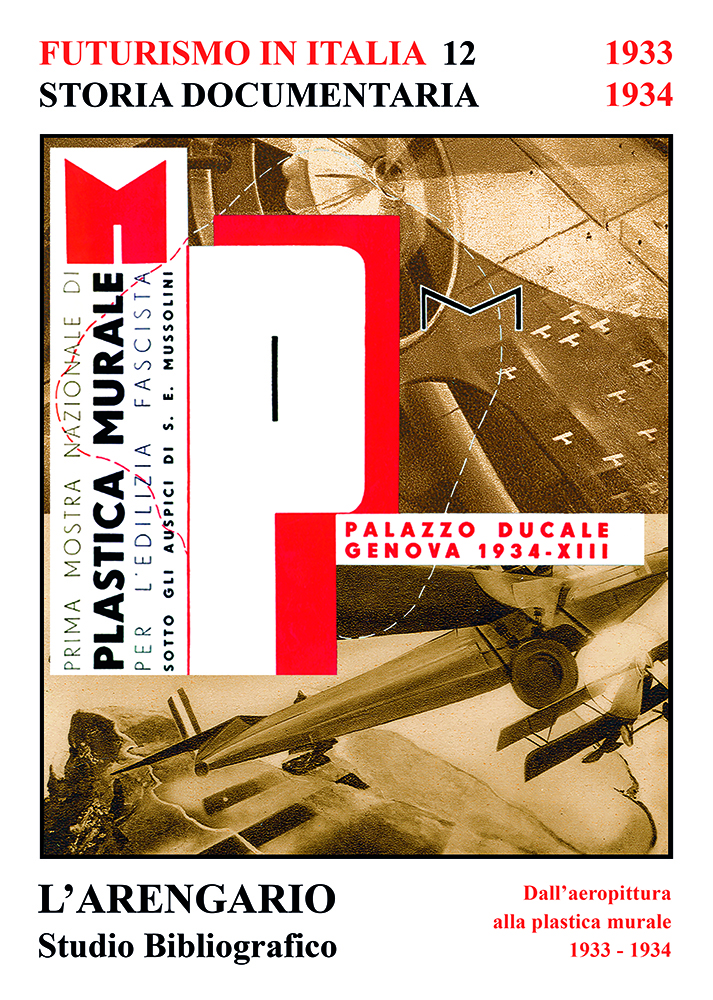L'ARENGARIO STUDIO BIBLIOGRAFICO - Dott. Paolo Tonini
Futurismo in Italia - 12. Dall'aeropittura alla plastica murale (1933 - 1934)
Luogo: Cellatica
Editore: L'Arengario Studio Bibliografico, "Storia Documentaria del Futurismo in Italia - 12"
Stampatore: prodotto in proprio
Anno: 2024 (29 luglio)
Legatura: brossura
Dimensioni: 29,7x21 cm.
Pagine: VIII - 152 (4) compresa la copertina
Descrizione: copertina illustrata a colori con un montaggio grafico di Paolo Tonini. Catalogo interamente illustrato a colori, 152 schede ragionate, a cura e con testo introduttivo di Paolo Tonini («Arte di Stato tra passatismo e futurismo» / «State Art between passatism and futurism»). Edizione digitale.
Bibliografia: N. D.
Prezzo: N. D.ORDINA / ORDER
"Che il futurismo fosse «vincente ovunque» era evidente, non solo per il modernismo ormai generalizzato ma per il peso crescente delle commesse statali nel quadro delle grandi opere pubbliche: architetti e pittori futuristi vi erano sempre più coinvolti e non solo per l’instancabile opera di propaganda di Marinetti ma per l’oggettiva funzionalità sia ideologica che pratica dell’aeropittura e della nuova architettura allo sviluppo dell’industria. Per la verità la poesia non ebbe lo stesso successo, e qui Marinetti millantava (ma quando mai la poesia ha avuto a che fare col “successo”?). Però Marinetti anche diceva la verità sui tanti men che ventenni in cerca d’altro dalla realtà com’era, e guardava con simpatia ai nuovi e dissenzienti futurismi, unica garanzia di una «atmosfera d’avanguardia»" (dal testo introduttivo).
"Futurism «winning everywhere» was evident, not only because of the widespread modernism, but also of the growing weight of state commissions within the framework of major public works: futurist architects and painters were increasingly involved, not just because of Marinetti’s tireless efforts in propaganda, but also because of the objective functionality, both ideological and practical, of aeropainting and new architecture for industrial development. In truth, poetry did not achieve the same success, and here Marinetti was boasting (but when has poetry ever had to do with “success”?). However, Marinetti was truthful about the many under-twenty-year-olds seeking something different from reality as it was and considered the new and dissenting futurisms with sympathy, like the only guarantee of an «avant-garde atmosphere»".
DOWNLOAD PDF FILE
"Futurism «winning everywhere» was evident, not only because of the widespread modernism, but also of the growing weight of state commissions within the framework of major public works: futurist architects and painters were increasingly involved, not just because of Marinetti’s tireless efforts in propaganda, but also because of the objective functionality, both ideological and practical, of aeropainting and new architecture for industrial development. In truth, poetry did not achieve the same success, and here Marinetti was boasting (but when has poetry ever had to do with “success”?). However, Marinetti was truthful about the many under-twenty-year-olds seeking something different from reality as it was and considered the new and dissenting futurisms with sympathy, like the only guarantee of an «avant-garde atmosphere»".
DOWNLOAD PDF FILE

